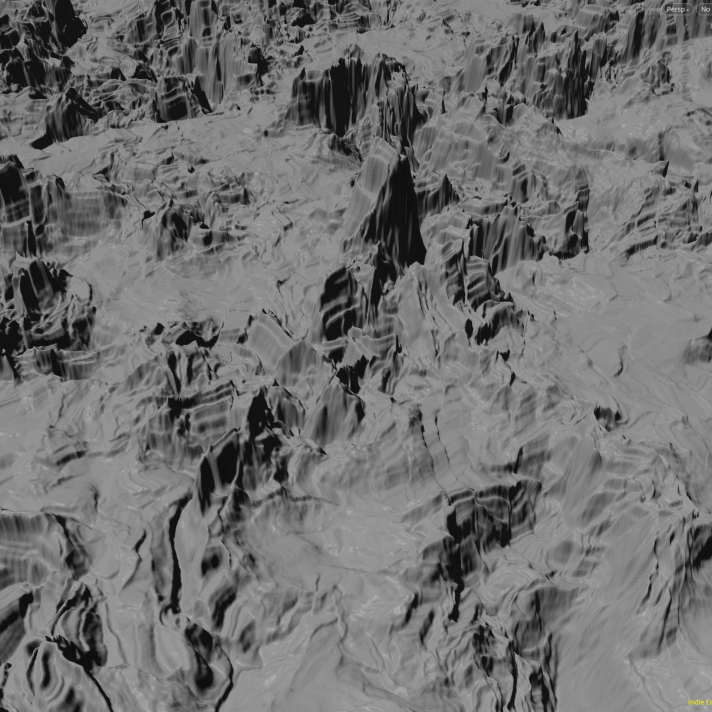Español
English below
Orbita Material Camp es una obra audiovisual que viene cómo una propuesta de entrar en un diálogo entre diferentes perspectivas: el sonido y la luz como motor para construir, crear y armar un espacio virtual, de esa forma poder vivir una experiencia desde un formato digital y sonoro, llegar a cuestionarnos cómo estos lenguajes tecnológicos entran hasta el punto de sentir la inmersión entre la realidad física y el espacio creado por códigos y frecuencias sonoras.
Desde que comenzó el confinamiento y me encuentro atrapado en la casa de mis padres, decidí invertir el tiempo en aprender algunas cosas nuevas, agregar más técnicas a mi arsenal de herramientas y expandir un poco más mis inquietudes creativas, pero como todo en este año, nada ha sido como lo planeé.
Entre las cosas que quería aprender esta Unity, un motor de videojuegos con muchas aplicaciones para arte interactivo, VR, AV y una muy buena integración con Houdini, una de mis herramientas favoritas.
Pero no me sumergí en el software y su potencial hasta que mi amiga María E. Pérez me invitó a participar junto con ella en el Festival Flashparty 2020, una demoparty que ha estado haciéndose desde 1998 en Buenos Aires, Argentina, un espacio muy interesante para exhibir y difundir creadores y artistas electrónicos y de las artes digitales, perfecto para experimentar con cosas nuevas.
Después de unos días explorando Unity, aprendiendo sus funcionamiento y revisando tutoriales me dediqué a un proyecto de creación de un ambiente VR donde me pudiera desplazar en tiempo real, y utilizar varios Height Field que venía haciendo en Houdini para los que todavía no había encontrado un uso específico.
De ahí en adelante fue construir todos los Digital Asset desde cero para crear y modificar a mi conveniencia, y en tiempo real este paisaje extra planetario.
El resultado final que presentamos fue algo relativamente sencillo, pero una gratificante sorpresa, Yo venía acostumbrado al lento y laborioso trabajo de crear altamente elaborados y complejos renders en Arnold, pero quedé fascinado por lo rápido de los resultados en Unity, un primer paso en esta nueva etapa de exploración de renders en tiempo real, algo que me abre todo un mundo de posibilidades para seguir avanzando en mi carrera artística.
Y por supuesto un placer seguir colaborando con María Emilia y su proyecto Vermillion, que siempre me aporta una nueva visión, diferente a la mía pero al mismo tiempo afín, y desde ya vamos pensando en nuevas y más elaboradas obras.
English
Orbita Material Camp is an audiovisual piece that comes as a proposal to enter into a dialogue between different perspectives: sound and light as the engine to build, create and assemble a virtual space, in this way being able to live an experience from a digital and sound format, come to question how these technological languages enter to the point of feeling the immersion between physical reality and the space created by sound codes and frequencies.
Since the isolation began and I am trapped in my parents’ house, I decided to spend time learning some new things, adding more techniques to my arsenal of tools and expanding my creative interests a little more, but like everything this year, nothing has been as I planned.
Among the things I wanted to learn was Unity, a videogame engine with many applications for interactive art, VR, AV and a very good integration with Houdini, one of my favorite tools.
But I did not immerse myself in the software and its potential until my friend María E. Pérez invited me to participate with her in the Flashparty Festival 2020, a demoparty that has been taking place since 1998 in Buenos Aires, Argentina, a very interesting space to exhibit and spread electronic and digital arts creators and artists, perfect for experimenting with new things.
After a few days exploring Unity, learning how it works and reviewing tutorials, I started a project to create a VR environment where I could move around in real time, and use various Height Fields that I had been doing in Houdini for which I had not yet found a specific use.
From there onwards, I built all the Digital Asset from scratch to create and modify this extra planetary landscape at my convenience, and in real time.
The final result we presented was relatively simple, but a gratifying surprise. I was used to the slow and painstaking work of creating highly elaborate and complex renders in Arnold, but I was fascinated by the speed of the results in Unity, a first step in this new stage of exploration of real-time renders, something that opens up a whole world of possibilities to continue advancing in my artistic career.
And of course it is a pleasure to continue collaborating with María Emilia and her Vermillion project, which always brings me a new vision, different from mine but at the same time related, and from now on we are thinking of new and more elaborate pieces.













